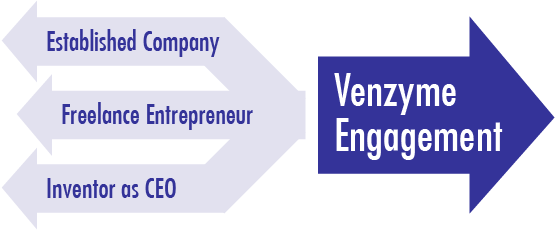Central Trilemma
Institutions that have great technologies often face the daunting problem of trying to find the right partner who has the same interest in seeing the technology come to market. Institutions often chose a partner with very different motivations which stifle the development of their otherwise viable technology. There are three avenues that institutions usually pursue.
Commercialization Strategies
Institutions often partner with existing companies to develop their technologies. Finding this match is frequently difficult, since corporations only acquire technologies that align with their strategic initiatives. Match-making is especially hard with a disruptive technology that demands a whole new business approach to fully realize its value. Even if an institution does find a corporate partner, however, there is a great risk that the technology will not be fully developed. There are three reasons for this:
- Focus. The company has many priorities; your technology is not the highest and it ends up being neglected.
- Strategy Shift. After the company signs its partnership with you, its priorities change... leaving your technology in the lurch.
- Defensive Shelving. The real reason the company signed its partnership with you was to prevent someone else from bringing your technology to market... so it acquires what you invented and puts it on the shelf to keep it from competing with their existing product lines.
Like existing companies, entrepreneurs each have their own "tastes" and interests when it comes to inventions. The best entrepreneurs often prefer "more developed" technologies: they are good at building businesses, not at conceiving them. As a result, the institution's technologies with the most potential often get ignored. Even when an entrepreneur gets excited about a technology, the licensing institution is gambling that the interested entrepreneur has "the right stuff." Institutions rarely have the expertise to judge the skill of an entrepreneur, so they are frequently disappointed.
Inventors frequently get frustrated by a lack of progress in getting their inventions onto the market. Some of these brilliant individuals figure business is a no-brainer, so choose to push forward the development themselves. Usually, however, these inventors have NO experience starting companies, do not have the needed management, planning, and people skills, and lack the objectivity needed to choose or change the strategic direction of the company. When inventors become entrepreneurs, they divert time away from science and their institution loses a talented scientist.
None of these choices are good—especially for a truly ground-breaking technology. Consequently, Venzyme offers a fourth choice:
We will:
We will bring to bear our years of experience in starting companies to unlock the potential of your technology and bring it to market where it can help people and make a difference to the world.
- Objectively determine if your technology will support a company
- Work with your inventor to identify technology milestones which may be necessary before a company can be founded
- Put together all the elements of the business story needed to attract the right executives and investors
- Build and support a management team with the right talents for this particular venture
- Find the funding to move the company forward
We will bring to bear our years of experience in starting companies to unlock the potential of your technology and bring it to market where it can help people and make a difference to the world.






